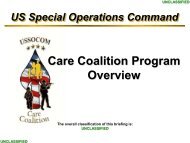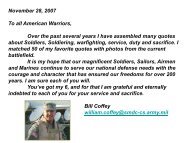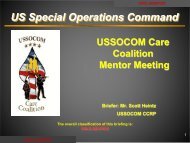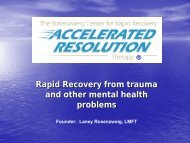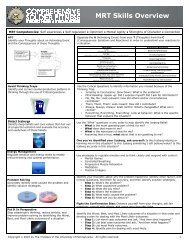Master Resilience Training - 9Line LLC
Master Resilience Training - 9Line LLC
Master Resilience Training - 9Line LLC
Create successful ePaper yourself
Turn your PDF publications into a flip-book with our unique Google optimized e-Paper software.
Module One:<strong>Resilience</strong>Copyright © 2010 by The Trustees of the University of Pennsylvania. All rights reserved.5
Module One, Unit One:<strong>Resilience</strong> and MRT CompetenciesCopyright © 2010 by The Trustees of the University of Pennsylvania. All rights reserved.7
<strong>Resilience</strong> and the MRTCompetencies: B.L.U.F.• B.L.U.F. (Bottom Line Up Front): You can enhanceyour resilience and effectiveness as a Participantby using skills that build the competencies thatcontribute to resilience.Copyright © 2010 by The Trustees of the University of Pennsylvania. All rights reserved.8
What is resilience?• <strong>Resilience</strong> is the ability to grow and thrive in theface of challenges and bounce back fromadversity.• It is built through a set of core competencies thatenable mental toughness, optimal performance,strong leadership, and goal achievement.Copyright © 2010 by The Trustees of the University of Pennsylvania. All rights reserved.9
Resilient people bounce,not break.YouNot YouCopyright © 2010 by The Trustees of the University of Pennsylvania. All rights reserved.10
This is resilience, too.• You’re juggling work and issues with other guys inyour unit, one of your kids keeps getting sick, anda Friend in your unit tells you that your supporthas made a big difference to him.• You’ve been under a lot stress lately, your spouseis starting a new job, and you made a brief to aCommanding Officer that was well-received.Copyright © 2010 by The Trustees of the University of Pennsylvania. All rights reserved.11
<strong>Resilience</strong> Myths and Facts<strong>Resilience</strong> MythNever show emotionAbout the individualMust handle everythingon your ownAlways act fastAccomplish superhumanfeatsAlways fully composedHave it or you don’tIt’s a destination<strong>Resilience</strong> FactRegulate emotionAbout individuals andrelationshipsAsking for help is a resilientstrategyKnow when to slow downBounce backNot always prettyEveryone can develop itIt’s a processCopyright © 2010 by The Trustees of the University of Pennsylvania. All rights reserved.12
MRT Competencies<strong>Resilience</strong> strenghtens 6 Core CompetenciesCopyright © 2010 by The Trustees of the University of Pennsylvania. All rights reserved. 13
MRT Competencies1. Self-awareness:• Identify thoughts, emotions, and behaviors• Identify patterns in thinking and behavior,particularly counterproductive patterns• Be open and curiousCopyright © 2010 by The Trustees of the University of Pennsylvania. All rights reserved.14
MRT Competencies2. Self-regulation:• Regulate impulses, emotions, and behaviors toachieve goals• Express emotions appropriately• Stop counterproductive thinkingCopyright © 2010 by The Trustees of the University of Pennsylvania. All rights reserved.15
MRT Competencies3. Optimism:• Hunt for what is good• Remain realistic• Identify what is controllable• Maintain hope• Have confidence in self and teamCopyright © 2010 by The Trustees of the University of Pennsylvania. All rights reserved.16
MRT Competencies4. Mental Agility:• Think flexibly and accurately• Take other perspectives• Identify and understand problems• Be willing to try new strategiesCopyright © 2010 by The Trustees of the University of Pennsylvania. All rights reserved.17
MRT Competencies5. Strengths of Character• Knowledge of top strengths and how to use themto overcome challenges and meet goals• Faith in one’s strengths, talents, and abilities• “I am strong” attitudeCopyright © 2010 by The Trustees of the University of Pennsylvania. All rights reserved.18
MRT Competencies6. Connection:• Strong relationships• Positive and effective communication• Empathy• Willingness to ask for help• Supporting othersCopyright © 2010 by The Trustees of the University of Pennsylvania. All rights reserved.19
MRT skills make you stronger,not softer.• They increase your ability to cope with stress.• They increase your ability to overcome setbacks.• They increase your ability to solve problems.• They increase your ability to remain task focused.• They increase your ability to perform underpressure.• They increase your confidence.• They decrease helplessness, depression, andanxiety.Copyright © 2010 by The Trustees of the University of Pennsylvania. All rights reserved.20
<strong>Resilience</strong> and MRTCompetencies: Key Principles• Bounce, not break: Resilient people bounce, notbreak, when faced with an adversity or challenge.• Can be developed: Everyone can enhance his orher resilience by developing the MRTcompetencies.Copyright © 2010 by The Trustees of the University of Pennsylvania. All rights reserved.21
Key Principles• Counteracts the negativity bias: You cancounteract the negativity bias–the tendency topay more attention to bad events than positiveevents–by recording three good things on aregular basis.• Optimism: Hunt the Good Stuff builds all of theMRT competencies; Optimism is a primary target.Copyright © 2010 by The Trustees of the University of Pennsylvania. All rights reserved.22
Mission Statement• Participants will learn seven skills that will makethem stronger Soldiers and better leaders bybuilding their mental toughness. These sevenskills will also develop their ability to understandthe thoughts, emotions, and behaviors ofthemselves and others.Copyright © 2010 by The Trustees of the University of Pennsylvania. All rights reserved. 23
MRT SkillsReal-time<strong>Resilience</strong>:Shut downcounterproductiveThinking to enablegreater concentration andfocus on the task at hand.Put It In Perspective:Stop catastrophic thinking, reduceanxiety, and improve problemsolving by identifying the Worst,Best, and Most Likely outcomes of asituation.Problem Solving:Accurately identify what caused the problem andidentify solution strategies.Energy Management:Regulate emotion and energy levels to enable critical thinkingand optimal performance.Detect Icebergs:Identify deep beliefs and core values that fuel out-of-proportion emotionand evaluate the accuracy and usefulness of these beliefs.Avoid Thinking Traps:Identify and correct counterproductive patterns in thinking through the use of Critical Questions.ATC:Identify your Thoughts about an Activating Event and the Consequences of those24
Our ModelCrawl Walk RunCopyright © 2010 by The Trustees of the University of Pennsylvania. All rights reserved.25
Skill mastery requires that youknow…• What is the skill?• When do I use it?• How do I use it?Copyright © 2010 by The Trustees of the University of Pennsylvania. All rights reserved.26
ATCCopyright © 2010 by The Trustees of the University of Pennsylvania. All rights reserved. 27
ATC: B.L.U.F.• ATC helps to build Self-awareness.• Identify your Thoughts about an Activating Eventand the Consequences of those Thoughts so youcan have greater control over your Emotions andReactions.Copyright © 2010 by The Trustees of the University of Pennsylvania. All rights reserved.28
ATC ModelBased on work by Albert EllisActivating EventThe trigger: achallenge,adversity, orpositive eventThoughtsYour interpretationsof the ActivatingEvent; what yousay to yourselfConsequences: ERE: EmotionsR: ReactionsCopyright © 2010 by The Trustees of the University of Pennsylvania. All rights reserved.29
Activating Event• An Activating Event (AE) is the who, what, when,where.• An Activating Event is the trigger. The situationcan be a challenge, adversity, or positive event.Copyright © 2010 by The Trustees of the University of Pennsylvania. All rights reserved.30
Thoughts• Thoughts are what you say to yourself in the heatof the moment, or your internal radio station.• Thoughts drive immediate reactions.• Thoughts can be productive or counterproductive.Copyright © 2010 by The Trustees of the University of Pennsylvania. All rights reserved.31
Consequences: ER• Emotions: What you feel in reaction to theActivating Event.• Reactions: What you do in reaction to theActivating Event.Copyright © 2010 by The Trustees of the University of Pennsylvania. All rights reserved.32
Activating Events:Debrief• Which situations do you already handle well?• Which situations do you need to handle moreeffectively?Copyright © 2010 by The Trustees of the University of Pennsylvania. All rights reserved.33
Emotions• Emotions are feelings and are usuallyaccompanied by physiological and behavioralchanges in the body.• Examples include anger, happiness, fear, love, etc.Copyright © 2010 by The Trustees of the University of Pennsylvania. All rights reserved.34
Identifying Emotions• Break into teams of five.• On a flip chart, list as many feelings as possible.• Write positive feelings (e.g., happiness) on theleft-hand side and negative feelings (e.g., anger)on the right-hand side.• Synonyms are okay.• You have three minutes.• Go!Copyright © 2010 by The Trustees of the University of Pennsylvania. All rights reserved.35
Emotional Effectiveness• We all have emotions that we handle effectivelyand other emotions that we don’t handle aseffectively as we need to.• Identify your effectiveness with a variety ofemotions.Copyright © 2010 by The Trustees of the University of Pennsylvania. All rights reserved.36
Thought-ConsequenceConnectionsThoughtsLoss(I have lost something.)Danger(Something bad is going to happen and Ican’t handle it.)Trespass(I have been harmed.)Inflicting harm(I have caused harm.)Negative comparison(I don’t measure up.)Positive contribution(I contributed in a positive way.)Appreciating what you havereceived(I have received a gift that I value.)Positive future(Things can change for the better.)Emotions/ReactionsSadness/WithdrawalAnxiety/AgitationAnger/AggressionGuilt/ApologizingEmbarrassment/HidingPride/Sharing, planning futureachievementsGratitude/Giving back, payingforwardHope/Energizing, taking actionCopyright © 2010 by The Trustees of the University of Pennsylvania. All rights reserved.37
Emotional Effectiveness:Debrief• Which emotions do you already handleeffectively?• Which emotions do you need to handle moreeffectively?Copyright © 2010 by The Trustees of the University of Pennsylvania. All rights reserved.38
Thoughts driveConsequences…Fight withsomeone youcare aboutI’ve been harmed,trespassed,thwarted…E:frustrated,irritated, angryR:Copyright © 2010 by The Trustees of the University of Pennsylvania. All rights reserved.39
Thought-ConsequenceConnections• Some people find that there is a pattern in theirThoughts–that they relate to a certain theme.• Noticing patterns in your Thoughts can help youto understand why you continually react the wayyou do.Copyright © 2010 by The Trustees of the University of Pennsylvania. All rights reserved.40
Self-fulfilling ProphecyFight withsomeone youcare aboutShe’s alwaysgetting on mycase.E:R:Copyright © 2010 by The Trustees of the University of Pennsylvania. All rights reserved.41
Self-fulfilling ProphecyUpcomingPT testI’m so out of shape.There’s no way I canmake that runtime. It’s hopeless.E:R:Copyright © 2010 by The Trustees of the University of Pennsylvania. All rights reserved.42
ATC: What’s the goal?• To separate the Activating Event, our Thoughtsabout it, and the Consequences• To identify patterns in our thinking that make usweaker or decrease performance• “Anyone can get angry–that is easy–but to getangry with the right person, to the right extent, atthe right time, for the right reason, and in theright way is no longer something easy thatanyone can do.”–AristotleCopyright © 2010 by The Trustees of the University of Pennsylvania. All rights reserved.43
ATC:Key Principles• Separate A, T, C: Separate the A from the Tfrom the C.– A: Just the facts–who, what, when, where– T: Your interpretation, what you say to yourself inthe heat of the moment– C: Your Consequences (ER)• Detect patterns: Identify any patterns in yourTs that undercut your performance and mentaltoughness.• Self-awareness: ATC builds all of the MRTcompetencies; Self-awareness is a primarytarget.Copyright © 2010 by The Trustees of the University of Pennsylvania. All rights reserved.44
ATC Practice• Activity:– ID ATC one recent Activating EventCopyright © 2010 by The Trustees of the University of Pennsylvania. All rights reserved.45
ATC Practice 1AE (who, what, when, where):Thoughts:What you said to yourself in the heat of themomentConsequences:ER: Emotions, ReactionsAsk yourself: Is my reaction helping or harming?Copyright © 2010 by The Trustees of the University of Pennsylvania. All rights reserved.46
ATC Practice:Debrief• What did you learn?• What patterns, if any, did you notice in yourThoughts and/or Consequences?• In what ways was your reaction helping orharming you?Copyright © 2010 by The Trustees of the University of Pennsylvania. All rights reserved.47
ATC: Applications• How can you use ATC to enhance yourperformance?• How can you use ATC to build strongerrelationships?Copyright © 2010 by The Trustees of the University of Pennsylvania. All rights reserved.48
DISCUSSIONCopyright © 2010 by The Trustees of the University of Pennsylvania. All rights reserved. 49
ATC:Check on LearningWhat is the skill? ATC is a method to identify your Thoughtsabout an Activating Event and the Consequences of thoseThoughts. Our Thoughts are under our control.When do I use it? Use ATC anytime you’re curious aboutyour Emotions or Reactions, when you don’t like yourreaction, or when you’re stuck in a pattern and wearing oneset of glasses.How do I use it? Describe the Activating Event objectively,identify your Thoughts, and identify your Consequences (ER:Emotions, Reactions).Copyright © 2010 by The Trustees of the University of Pennsylvania. All rights reserved.50



